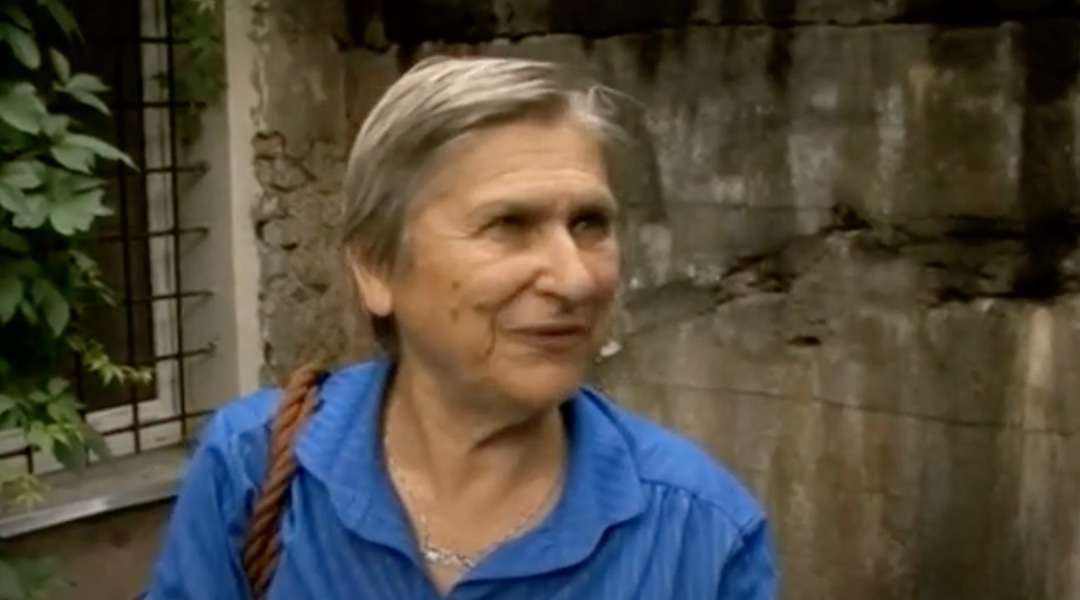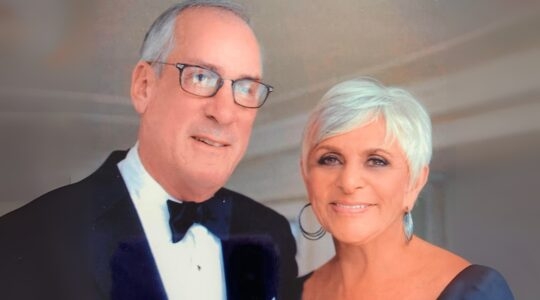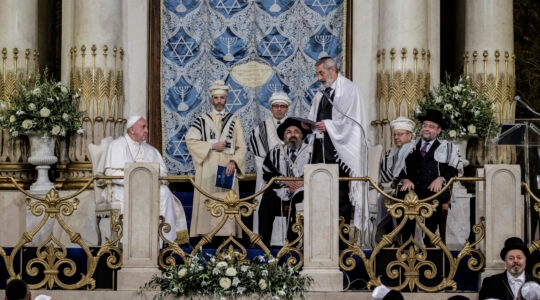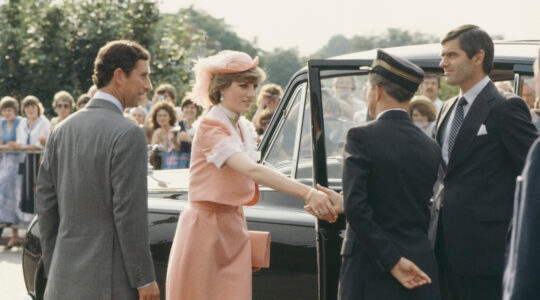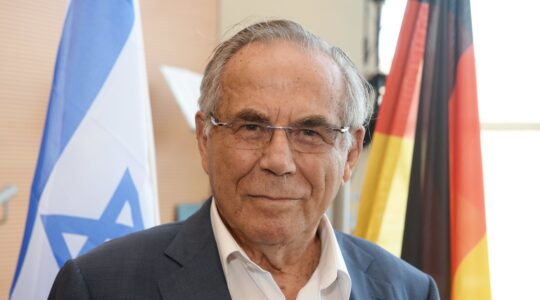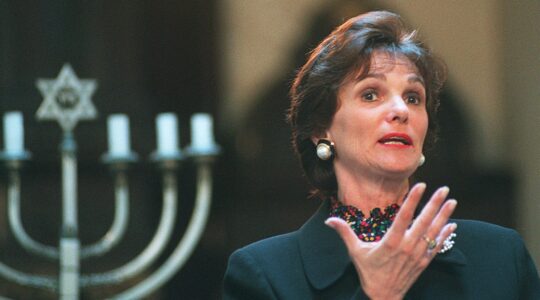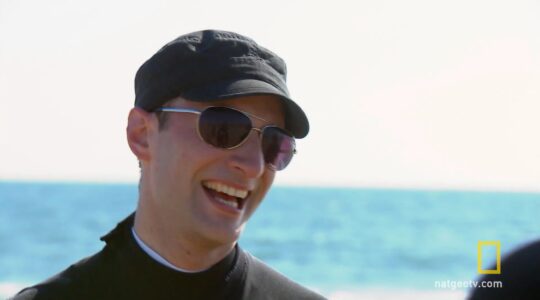Lithuania’s Jews and Yiddishists around the world are mourning the passing of Fania Brantsovsky, the last surviving member of the Jewish underground in the Vilna ghetto and a keeper of the flame of the city’s once glorious Yiddish past, who died at the age of 102 on Sunday in Vilnius.
Brantsovsky escaped the ghetto in 1942 and fought against the Nazis and their local collaborators in the Rudninkai forest with a group of Jewish partisans under the command of Abba Kovner.
In the years after the war, she became a lifelong advocate for the memory of Lithuanian Jewry and their Yiddish language, serving as the librarian and beloved teacher at the Vilnius Yiddish Institute and an ambassador to visitors she brought to view the landmarks, many vanished, of a city that had once been known as the “Jerusalem of Europe” for its rich Jewish culture.
It was a role that brought her world-wide acclaim and eventually local hostility, when Lithuanian nationalists began to equate her Soviet liberators with the Nazis, and tried to discredit partisans like her who had once considered the Russians their allies.
For all these roles, Brantsovsky was hailed by Yiddishists around the world who consider her death the end of an era.
“She lived so long that she came from a completely different universe than ours, like out of a history book,” Alec “Leyzer” Burko, a Warsaw-based Yiddish teacher, told the Jewish Telegraphic Agency.
“We’ve lost the last exemplar of interwar Yiddish Vilna, someone who could impart the spirit of the Yiddishist movement of interwar Vilna and its secular circles. We lost our last active veteran of the Vilna ghetto and the Jewish partisans,” said Dovid Katz, an American-born Yiddishist and co-founder of the Vilnius Yiddish Institute.
“And on a personal level,” he added, “we’ve lost a dear friend whose warmth, enthusiasm, encouragement, and desire to help, show and teach was a huge inspiration.”
Brantsovsky was born Feige Jocheles in 1922, in the then-Lithuanian capital of Kaunas but her family moved to Vilnius, then a part of Poland, when she was just five years old.
As a young girl, she was active in the rich Jewish life of Vilnius. At the time, Vilnius was home to more than 60,000 Jews and boasted over 100 synagogues, the largest of which had seating for more than 2,000. With a Jewish community that had been flourishing when Napoleon passed through the city in the 18th century, Vilnius was more than just a religious center. It was home to a rich cultural and political scene, all in the Yiddish language.
While she hailed from a secular family, which Brantsovsky noted kept neither kosher nor Shabbat, she completed her entire traditional education in Yiddish-speaking schools, and as a teenager was active in Jewish political youth movements
That world was shattered in 1941, when Vilnius fell under the control of the Germans and Brantsovsky, along with Vilnius’s tens of thousands of other Jews, were herded into the cramped conditions of the Vilna ghetto.
From the first days of the Nazi occupation of Lithuania, they began taking Jews from Vilnius to be killed in the nearby Ponar forest. Over 100,000 people would be killed there, including 70,000 Lithuanian Jews and 8,000 Roma, making it the second-largest mass grave in Europe after Babyn Yar in Ukraine.
“Our life was more of existence, really,” Brantsovsky once described the ghetto in an interview with Centropa, a European Holocaust memorial organization. Every day was a struggle for survival, and one slip-up or turn of fate could mean starvation, or deportation to Ponar.
Brantsovsky recalled hearing of a resistance movement forming in the ghetto and quickly requested to join.
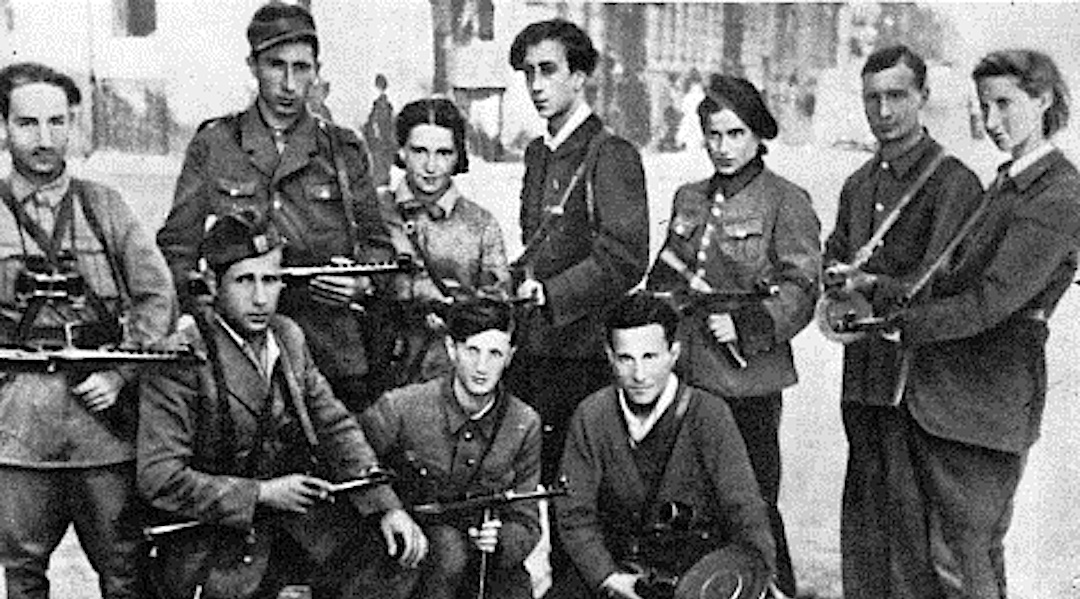
Abba Kovner (back row, center) with members of the Fareynikte Partizaner Organizatsye, or FPO, the United Partisan Organization, in Vilna. (Wikipedia)
“The underground organization of the ghetto united all parties and trends such as communists, revisionists, Bund etc. Their common goal was to fight against fascists,” she told Centropa.
That group would be remembered as the United Partizan Organization, or by its Yiddish initials, FPO.
The FPO had considered instigating an uprising in the ghetto, as would later take place in Warsaw. After the capture and execution of it’s leader Yitzhak Wittenberg by the Gestapo, the movement’s leadership decided instead to take its fighters out of the ghetto and into the nearby forests where Soviet-backed partisans were harrying the rear and supply lines of the German army.
Brantsovsky bid farewell to her family and was smuggled out of the ghetto on Sept. 23, 1943. She would later learn that on the same night, the Germans began their final liquidation of the ghetto, killing most of its inhabitants. None of her family would survive the Holocaust.
In the Rudninkai forest, which has been immortalized in partisan literature under its Yiddish name, Der Rudnitzker Vald, she joined up with a partisan unit composed of Jews under the command of Abba Kovner, known as the Nokmim or Avengers.
In the forest she trained with weapons and explosives and took part in military operations against the Nazi occupation.
“We blasted trains and placed explosives in the enemy’s equipment. We shot and killed them,” she told Centropa. “Yes, I did, I killed them and did so with ease. I knew that my dear ones were dead and I took my revenge for them and thousands of others with each and every shot.”
In the forest, she also met her future husband Mikhail Brantsovsky. Nearly a year after fleeing the ghetto, Fania returned, rifle in hand, as the Soviet Red Army captured the city.
Less than a month after returning she and Mikhail married.
“We were intoxicated by the victory, our youth and love,” she recalled.
After the war, her commander Abba Kovner would gain fame as one of Israel’s poet laureates, and infamy for an aborted plot to kill 6 million Germans in vengeance for the Holocaust.
Brantsovsky took part in none of that: She stayed in Vilnius where she and Mikhail built a life together and had two children.
In the years after the war, it quickly became clear to Brantsovsky that the world of her youth had been lost.
“There were hardly any Jews left in Vilnius. When I saw older Jews, or they looked old to me considering how young I was, I felt like kneeling before them to kiss their hands.” she once recalled.
Fania quickly went to work, helping to document what had been lost, and assisted Soviet Jewish writers Ilya Ehrenburg and Vasily Grossman in the “Black Book of Soviet Jewry,” a 500-page document that recorded the Nazis’ crimes in the occupied regions of the Soviet Union.
While it was first published in the USSR by Der Emes, the Yiddish-language arm of Pravda, the book would later be suppressed as the Soviet policy towards the Holocaust shifted to present the genocide as solely an atrocity against Soviet citizens, not one that specifically targeted Jews.
Though Mikhail and Fania had been present and honored in Moscow’s Red Square during the victory parades of 1945, their enthusiasm towards the Soviet regime dulled after experiencing the antisemitism of Stalin’s later years.
Mikhail passed away in 1985, and Fania retired from her job as a teacher in 1990 just before Lithuania gained its independence.
In retirement, Fania found a new purpose: In an independent Lithuania, there was renewed interest in recording Vilnius’s Jewish past and studying the Yiddish language of its Jews.
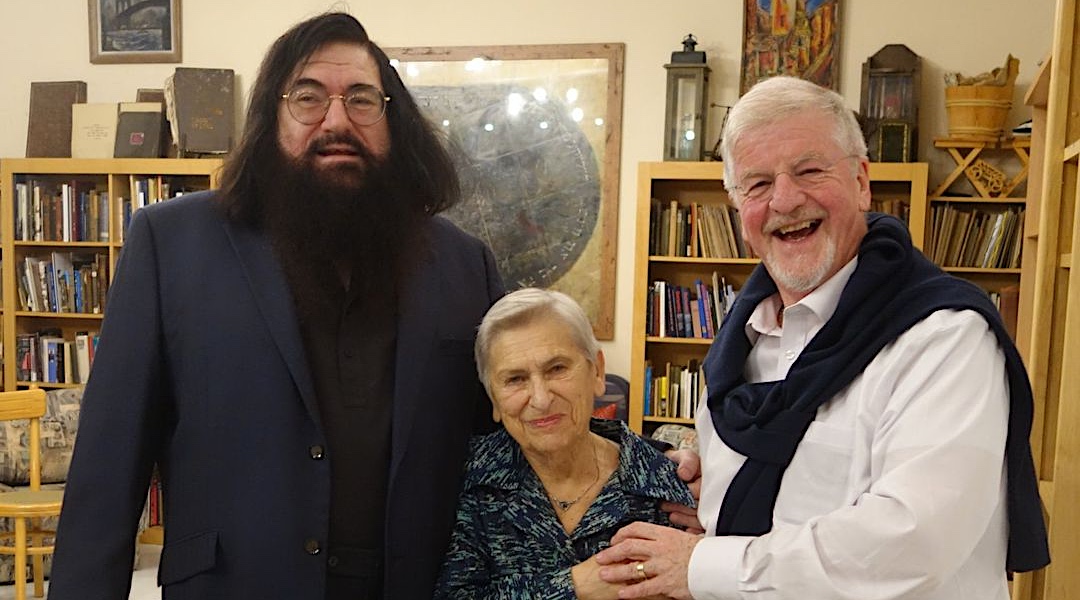
Dovid Katz, co-founder of the Vilnius Yiddish Institute; Fania Brantsovksy and Dónal Denham, Ireland’s former ambassador to Lithuania, at a reunion in Vilnius, Nov. 6, 2019. (Courtesy Dovid Katz)
In the early 1990s, Fania and a group of other survivors, including another former partisan, Rachel Margolis, worked to establish a Holocaust museum in Vilnius known as the Green House.
In 2001, Katz, a professor of Yiddish who had previously worked at Oxford, relocated to Vilnius and established a Yiddish institute at Vilnius University.
“When I founded the Vilnius Yiddish Institute in 2001 my first executive act was to hire Fania as librarian and that choice was a success from day one,” Katz told JTA.
Fania, who worked as a teacher much of her adult life, originally trained to do so in Yiddish for students in the city’s Jewish school system. The Nazis shattered that future, but decades later, the Vilnius Yiddish Institute represented a return to her roots.
“She understood that she was the carrier of so much of the living Yiddish culture of the interwar period, especially its secular Yiddishist incarnation,” Katz explained.
The Institute lasted for 17 years, until it ultimately closed down in 2018. Every year it ran a summer program attended by students from around the world, and Fania became a fixture of the experience, telling students about the city of her youth, the experience of the ghetto and bringing them out to the remains of her partisan camp in the Rudninkai forest well into her nineties.
She is remembered fondly by nearly everyone who passed through.
“I feel really blessed to have had an opportunity to work with her,” Indre Joffyte, who helped run the program, told JTA. “Fania’s energy, determination and passion in everything she did was an inspiration to everyone around her. I will always remember her caring nature, our girly conversations, her preparedness to help, and her inner youth despite her age and tragic life experiences.”
In independent Lithuania, Fania became a prominent figure in its Jewish community as well as in diplomatic circles, guiding visiting leaders on tours of the former ghetto and Ponar where so many of her relatives were killed.
But the increased attention also invited trouble.
In the years since the fall of the Soviet Union, a nationalist narrative arose in the Baltic states that equated the actions of the Soviets with the Nazis.
Known as the “double genocide” theory, it has been largely rejected by Jewish and western Holocaust institutions, but has become the standard presented in Lithuania and the other Baltic states.
It resulted in a smear campaign directed against Brantsovsky and other surviving Jewish partisans, such as Margolis and Yitzhak Arad who was the director of Yad Vashem from 1972 to 1993.
For fighting in units allied with the Soviets, they were accused of being war criminals on the same level as Lithuanians who collaborated with the Nazis.
“I agree completely with all the anti-Communist pronouncements. What I disagree with is, of course, the equalization of the people who committed the genocide at Auschwitz and the people who liberated Auschwitz. They’re simply not the same.” said Katz. “As much as one should hate the Stalinist Soviet Union between 1941 and 1945, we were in the American-Anglo-Soviet alliance, and the Soviet Union was the only force fighting Hitler in Eastern Europe. So of course, Fania’s partisan union was aligned with the Soviet partisans in the forest who were fighting.”
Katz believes that the demand was in retaliation for increased pressure from the Simon Wiesenthal Center and other Jewish institutions for Lithuania to investigate its own wartime collaborators.
The charges were dropped that same year, but the incident had a notable effect on Brantsovsky, resulting in her receding somewhat from public life in Lithuania.
She didn’t stop teaching Yiddish, however, and was active in working with students and guiding tours until her 99th year, when she had a fall on the eve of the COVID-19 pandemic.
With her passing, another thread connecting Eastern Europe’s Jewish past and rich Yiddish culture has been severed.
“She was one of the last witnesses of prewar Jewish life in Vilna, a proud graduate of its Yiddish school system where everything from chemistry to Latin and Shakespeare was studied in the Jewish community’s native language,” Jordan Kutzik, a former deputy Yiddish editor at The Forward, said in a memorial post on Facebook.
“After nearly her entire family and cultural milieu were murdered and then her native language suppressed for 50 years, she wasn’t wasting any time in helping to document her city’s history and encouraging others to explore it.”
JTA has documented Jewish history in real-time for over a century. Keep our journalism strong by joining us in supporting independent, award-winning reporting.
